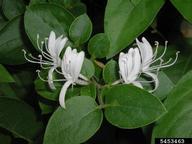Fall is the best time to attack Japanese honeysuckle (Lonicera japonica), and you can learn all about it in the Fact Sheet: Japanese Honeysuckle published by the Blue Ridge Partnership for Regional Invasive Species Management (PRISM)

Hand pulling young Japanese honeysuckle vines is effective only if all roots are removed. Any roots left in the soil will resprout. A foliar spray may be a more effective way to kill the entire plant. The best time to spray is autumn and early winter after most native plants have lost their leaves or are dormant, but before a hard freeze (25°F). Foliar sprays are less effective in spring because the herbicide does not thoroughly move from the leaves into the roots during spring growth.
Due to its bright red and yellow fruits, Asiatic bittersweet (Celastrus orbiculatus) is easy to spot in the autumn, and this is a good time to eradicate it. If you’d like to watch a video about this invasive, check below.
Here are the control methods for Asiatic bittersweet suggested by Blue Ridge PRISM:
Manual: Hand pull small seedlings and vines being sure to remove the crown and all large roots. Do not pull vines from trees; this is hazardous to people on the ground and can damage the trees.
Cut Stump: Cut small to large vines near ground level using a hand pruner, hand saw, or chainsaw. Immediately apply a concentrated herbicide to the cut stump to prevent resprouting, June – February with late summer – fall ideal.
Foliar Spray: Low bushy vines or resprouted vines can be treated with a foliar herbicide spray from June – October. You should avoid spraying large vines overhead (best to cut stump these). To avoid harming desirable plants, apply foliar spray when other plants are leafless in late fall, but while bittersweet leaves are still green/yellow.
— Blue Ridge PRISM Weed Alert-October- Asiatic Bittersweet
For more information, see Fact Sheet: Asiatic Bittersweet/Blue Ridge PRISM and Invasive Plant Control Calendar, May 2022 issue of The Garden Shed.
PESTICIDE WARNING
Pesticides (which include herbicides, insecticides, rodenticides, etc.) are poisonous. Always read and carefully follow all precautions and safety recommendations given on the container label. Store all chemicals in the original labeled containers in a locked cabinet or shed, away from food or feeds, and out of the reach of children, unauthorized persons, pets, and livestock. Consult the pesticide label to determine active ingredients, signal words, and proper protective equipment. Pesticides applied in your home and landscape can move and contaminate creeks, lakes, and rivers. Confine chemicals to the property being treated and never allow them to get into drains or creeks. Avoid drift onto neighboring properties and untargeted areas.
Featured Photo: Leslie J. Mehrhoff, University of Connecticut, via Bugwood.org (CC BY 3.0)